Abstract
Mandibular fractures are common facial lesions typically treated with titanium plate and screw systems; nevertheless, this material is associated with secondary effects. Absorbable material for implants is an alternative to titanium, but there are also problems such as incomplete screw insertion and screw breakage due to high pretension in the screw caused by the insertion torque. The purpose of this paper is to find the optimal screw pretension (SP) in absorbable plate and screw systems by means of artificial neural network (ANN) and its inverse (ANNi). This optimal SP must satisfy a desired maximum von Mises strain (MVMS). For training the ANN, a database was generated by means of a design of experiments (DOE). Each DOE configuration was solved by means of finite element method (FEM) calculations. To obtain the optimal value for (SP) in the mini absorbable screw for fracture fixation, a strategy to invert the ANN is developed. Using the ANN coefficients, a sensitive study was performed to identify the influence of the design parameters in the MVMS. The optimal SP obtained was 14.9742 N. The MVMS condition was satisfied with an error less than 1.1% in comparison with FEM and ANN results. The screw shaft length is the most influencing MVMS parameter.
1. Introduction
Some authors have found that one of the most common facial lesions are mandibular fractures due to traffic accidents, violence, falls or sports [1,2,3]. Currently, advances in the ability to treat mandibular fractures have been gained and, typically, titanium screws are used to hold a plate which fixes the fracture. Titanium is chosen because of its high stiffness and strength. However, this property makes the implant to support most of the mechanical load and cause a loss of bone mass in the vicinity of it, this effect is called stress shielding [4,5]. Other problems reported with titanium implants include palpability, pain and the need for subsequent removal. For these reasons, absorbable plate and screw systems are commonly used for maxillofacial surgery, as they prevent the stress shielding, reduce the risk of infection and avoid the need of secondary surgery for removing implants. However, there are also problems related with the use of absorbable systems such as incomplete screw insertion and screw breakage [6,7,8,9]. Therefore, the correct application of the insertion torque prevents the complication of screw breakage [10]. While this insertion torque is applied, a tensile stress named pretension is generated in the screw body and, once the implant is in place, this is maintained. Thus, it is important to define the optimal pretension in plate and screw absorbable systems, which depends on the geometry of the screw, the contact angle, friction coefficient and mechanical properties of the parts [11].
Most studies related to the optimization of screw design focused only on one or two parameters and do not take full advantage of finite element method (FEM) software. On the other hand, the total number of simulations to investigate all possible combinations of parameters can be very large, hence, the use of the design of experiment (DOE) layout is feasible to have an adequate number of them, in order to reduce experimental efforts [12].
Moreover, artificial neural networks (ANNs) are now commonly used in many areas, such as engineering and medical science, as they are helpful models for, among other things, prediction and optimization. The ANNs function similar to a human brain, imitating the adjustments to the synaptic relationship between and among neurons in the learning process. An advantage of ANNs is the easy to use and accurate models obtained [13].
Consequently, the aim of this paper is to find the optimal screw pretension (SP) for a mini plate and screw absorbable system for fracture fixation when desired value for maximum von Mises strain (MVMS) in absorbable screw is set and its geometric parameters are known. To achieve this, the methodology proposed in [14] is applied. The inverse artificial neural network (ANNi) is a variant of the ANN that has been implemented in several processes to determine the optimal parameters successfully [15]. The inputs of the data base used to train the ANN were constructed based on a DOE, whereas the output, MVMS, was calculated by the means of FEM.
2. Materials and Methods
A methodology is proposed to find the optimal value of SP which satisfies a required MVMS. This methodology includes DOE layout, FEM simulations and ANN. The levels of the design factors are disposed in a DOE layout to have an arrangement where it is ensured that they are all combined, which allows us to have a systematic way of generating the input values that, in conjunction with the results of the FEM simulations used as output, are used to create a database for ANN training. Then, the ANN was used as surrogated method to predict the MVMS and inverted to develop an objective function, which was minimized using the differential evolution (DE) algorithm. The sequence of activities is presented in Figure 1.
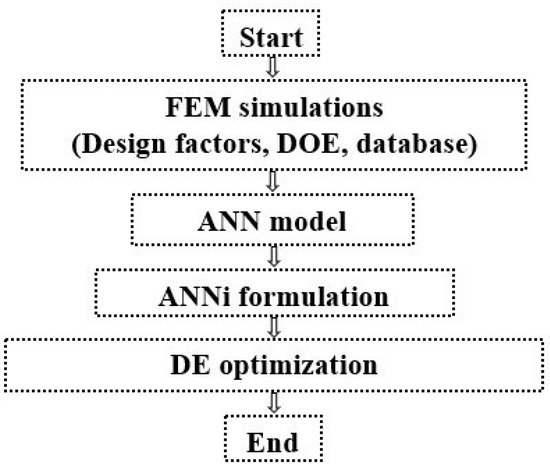
Figure 1.
Activity flow diagram for methodology developed.
The optimal value for MVMS was set to 19 × 10−3. To satisfy this condition, only the value of SP was considered as design factor, whereas the screw geometry was constant, according with a commercial screw-plate absorbable system dimension.
2.1. Design Factors for Database Preparation
This paper uses the layout of a DOE in order to avoid repeated information in the input data for the training of neural network, and thus facilitate learning for the desired output values. We use, as a base, the configuration of a full factorial design with 5 factors and 2 levels to generate different combinations. Factors considered are the inner diameter (ID), length of the shaft (LS), angle of the thread shape (AT), threads number (TN) and (SP) according to [12,16]. High and low levels for each factor are shown in Table 1.

Table 1.
Factors and levels for design of experiments (DOE) arrangement.
The arrangement includes 32 analyzes in which MVMS for the mini screw was recorded as the output value.
2.2. Numerical Simulation
Simplified bone segments were modeled to evaluate the different design configurations of the absorbable mini screw, which consists of quadrangular prisms of 8.7 mm per side, 15 mm depth, and were threaded in center according to geometry of each arrangement of the DOE. Bone, screw and plate models were created by using the software Solidworks. To avoid singularities during the analysis, pronounced angles in the neck or head of the screw were avoided and global contacts between cortical and trabecular layers of bone, plate and screw were considered. The corresponding screw and plate configurations were inserted into assembly and then, exported in order to obtain the output value by means of FEM software with ANSYS V18.1. Figure 2 identifies the selected geometry factors for mini screw.
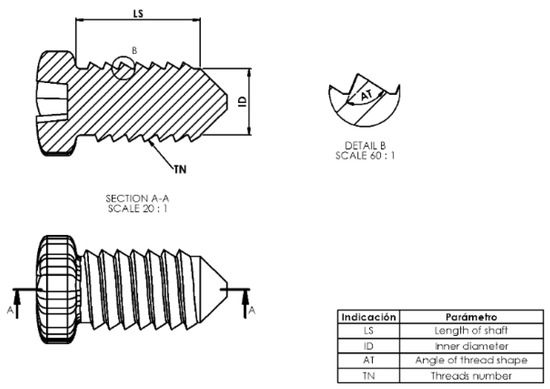
Figure 2.
Selected parameters of mini screw for DOE arrangement.
Bone is a composite natural material with certain complexity when determining their mechanical properties, as they are dependent on many factors. Nevertheless, the analysis can be simplified assuming the behavior, of the 2 layers composing the bone, as lineal elastic isotropic material, since the loads that act on the implant are low [17]. To perform the FEM calculations, the cortical bone layer was modeled with a thickness of 2 mm, whereas trabecular bone of 13 mm. Table 2 shows the mechanical properties assigned to bone layers and absorbable implant [18,19,20].

Table 2.
Mechanical properties assigned for finite element method (FEM) analysis.
A mesh model of the commercial absorbable screw and plate system with 10,303 nodes was created and its computed MVMS compared with 11,501 nodes mesh model, in order to test convergence, obtaining less than 1% of variation. Quadratic tetrahedral structural solid elements with ten nodes and three degrees of freedom at each node were used for all models, although the number of elements had slight variations due to changes in design parameters. Fixed support was applied at the bottom of the bone model and global contact condition between components was chosen for screw-bone interface to take into account osseointegration conditions. The material properties and boundary conditions assigned to perform the FEM analysis are described in Figure 3.
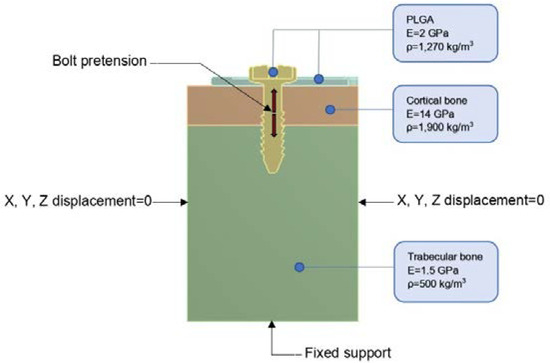
Figure 3.
Material properties and boundary conditions for FEM analysis.
2.3. Artificial Neural Network
ANN is employed as a surrogated method to predict a specific response from a process. In ANN, artificial neurons are interconnected with an associated weight coefficient and are grouped in layers. The first layer is called an input layer connected to a one or more hidden layers, which use a transfer function to obtain a response, followed by an output layer that generally uses a linear transfer function. According to [21,22], the hyperbolic transfer function is most suitable for hidden layers. Each layer contains several neurons. In the case of input and output layers, the quantity of neurons is equal to the number of input and output variables respectively, whereas in the case of the hidden layer, the number of neurons is defined in terms of the predictive accuracy level of the ANN model. To obtain the transfer function argument, the bias in the hidden layer must be considered, which is added to the weight coefficients. Under these conditions, the output of ANN is obtained by using Equation (1).
Here, is the predicted value, is the weight coefficient of output layer, is the weight coefficient associated to hidden layers, is the input variable, is the bias associated to hidden layers, is the bias of the output layer, subscript is the output number, subscript is the hidden neuron number, and subscript is the input number. In order to have input data that allow us to efficiently calculate the parameters of the ANN, each value was scaled using the min-max scale linear mapping, to ensure that they begin within the range of the transfer function [23]. Hence, normalized value is calculated by using Equation (2):
where is the unnormalized value and are the extreme values of the input data.
Once the network structure is defined, database is used to adjust the weights and biases coefficients. This procedure, named training, is performed to minimize the error of the output of the function with respect to a known output value stored in the database. There are different methods for training neural networks in which the second order algorithms stand out due to the higher convergence speed and ability to handle complex problems with compact network sizes. Within these methods, the Levenberg–Marquardt is the most relevant for industrial uses and can be found in various applications. The method consists of generating an output, Zp, from calculating the dot product between the inputs and neuron’s weight vectors, which acts on the activation function. Then, function f models the remaining neural network and produces the output, Op. The weight of the network is updated by using Equation (3)
where g is the gradient vector, H the Hessian approximation matrix, I the identity matrix, and μ the learning parameter [24,25].
In this paper, we use, as a database for the ANN, the arrangement of DOE, taking the 80% data for training the network and correlating its output and FEM values as a criterion of adequacy of the model. The remaining data were used to test the ANN. Simplified scheme of network created to obtain a function to predict the MVMS in the absorbable mini screw is observed in Figure 4.

Figure 4.
Scheme of the process used for neural network learning.
The performance of the ANN was evaluated by the mean square error (MSE) and the correlation coefficient (R2). Both methods are defined by Equations (4) and (5) respectively:
Here, is the output predicted by ANN, is the output predicted by FEM, is the average of actual values, and is the number of samples. In addition, the intercept () slope () test was performed to know the level of confidence of the ANN. In this test, a defined confidence level is reached if between slope limits a one is found, whereas, between the intercept limits, a zero is found [26].
Moreover, when certain output value is desired, and all other important parameters are well established, it is possible to develop a strategy to invert the ANN (ANNi), with the purpose to find the solution to an optimization problem. In ANNi, Equation (1) is arranged in a way that the difference between a desired output and the output predicted by ANN, Y, becomes in an objective function which involves a desired output and the operating parameters which minimizes it by means of an optimization method. This optimization strategy was developed by [14].
2.4. Artificial Neural Network Inverse
The relative importance of input variables was calculated by using Equation (6) to assure that they have a strong effect on the output value. This equation was proposed by Garson based on the partitioning of connection weights where Ii is the relative importance of the ith input variable on the output variable, subscript i is the input variable, subscript j the neurons in the hidden layer, Wij,i is the weight to the jth neuron of hidden layer from ith input variable, Woj,i is the weight to output layer from jth neuron of hidden layer, m is the number of inputs and n is the number of neurons [27].
3. Results
In this paper, we are varying geometric parameters and pretension of an absorbable mini screw used for bone fixation in an absorbable screw-plate system. The database, as observed in Table 3, includes 32 configurations based in a DOE layout and was split into 2 parts. The 80% data correspond to learning stage and the other 20% were used for testing the network. The recorded output obtained from FEM analysis was the MVMS value. The strain concentrated regions were similar in all the simulations and MVMS for each configuration was found in the shaft, as shown in Figure 5.

Table 3.
Full factorial design of 2 levels and 5 factors for mini screw.
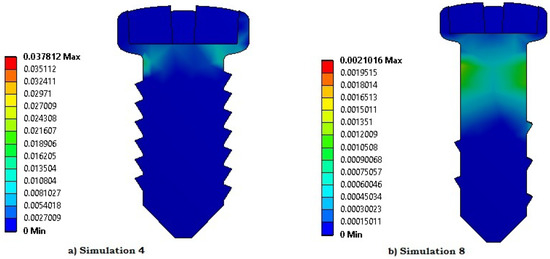
Figure 5.
Strain distribution in screw for (a) Simulation 4, and (b) Simulation 8.
Inputs and outputs were normalized from 0.1 to 0.9 and, after that, the values of biases, weights and number of neurons in hidden layer were calculated in the training stage using Matlab tool for neural networks. The resulting configuration of the ANN was with 5 neurons in input layer, 3 neurons in hidden layer and 1 neuron in output layer. Table 4 gives the obtained parameters for weights and biases that best fit the ANN model.

Table 4.
Adjusted weights and biases for proposed ANN.
The MVMS can be calculated by Equation (7), which includes the coefficients obtained from the ANN.
where:
Figure 6 shows the comparison between MVMS from the numerical solution and predicted values from the ANN. Data were compared with linear regression model obtaining an R2 of 0.9938. The obtained MSE was of 9.6925 × 10−7.
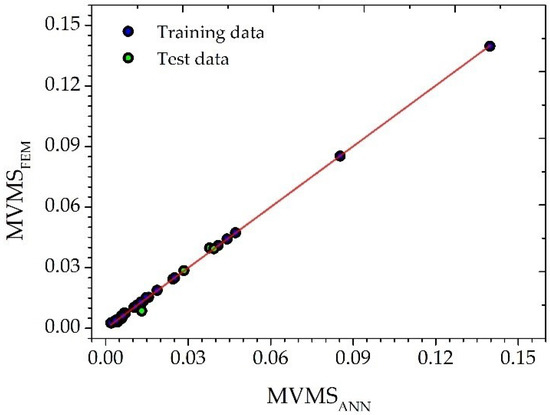
Figure 6.
Comparison of FEM and ANN values of MVMS for absorbable mini screw.
The intercept-slope test was run with a confidence level of 99%. The results are presented in Table 5. As is observed, the confidence level is reached due to a 0 and 1, found between intercept and slope limits. Based on these findings, it is concluded that the ANN proposed model is capable to accurately predict the MVMS.

Table 5.
Intercept-slope test for ANN.
Using (6), we calculate the relative importance for each input. All variables have a strong effect on the output. Furthermore, LS is the most influential parameter (37.85%), followed by ID (21.71%) and SP (13.95%), while TN (13.69%) and AT (12.8%) are the least. The effect of LS and ID on MVMS is due to the increasing or decreasing the contact area between the mini absorbable screw and bone. Thread number and angle of the thread shape have a relative low contribution to MVMS value.
Nevertheless, to ensure the success of mini absorbable screw plate system, the adequate SP must be applied on the mini screw to avoid breakage or migration due to inadequate installation.
Once ANN model is obtained, it is possible to apply the ANNi to estimate the optimal conditions for value of SP [14,24,28]. The optimization was proposed considering that all the design factors are known, except for SP. Equation (1) can be expressed as shown in Equation (11).
Equation (12) is used to involve Ink = 4 as the input to be optimized.
The term of the left side in Equation (12) is moved to the right side and now the equation is expressed as function of SP as in Equation (13).
A desired value of MVMS will be reached if the result of Equation (13) is zero and thus the value of SP which satisfies this condition is also obtained. This is a typical optimization problem, and an algorithm is required to solve it. For this purpose, the differential evolution algorithm was employed.
The design factors used in the ANNi and the desired value of MVMS are presented in Table 6. These values were established based on the geometry of a commercial mini absorbable screw.

Table 6.
Design factors and MVMS for ANNi.
Equation (14) defines the function which will be minimized. To avoid values less than zero, the result of must be an absolute value.
Here:
The differential evolution algorithm was applied through 2000 generations with a population of 50 specimens. The scale factor and the crossover rate parameter were set to 0.4 and 0.8, respectively.
The obtained result of was 1.0845 × 10−4, whereas the optimal value of SP was 14.9742 N. The value of MVMS calculated by means of Equation (7) was 19.1 × 10−3 m. Moreover, a FEM analysis was performed using the design factors of the ANNi and its optimal SP, obtaining a MVMS value of 19.21 × 10−3, as shown in Figure 7.
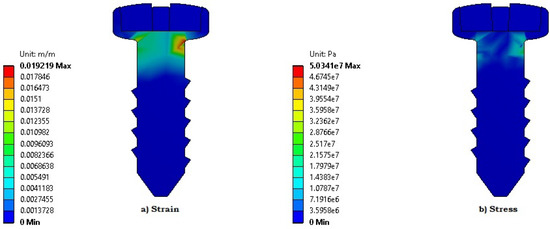
Figure 7.
FEM analysis with design factor values of ANNi and calculated SP: (a) Strain; (b) Stress.
The difference between calculated MVMS and the proposed target was 0.52% for ANN, whereas for FEM analysis was 1.09%. Moreover, the error was 0.57% comparing MVMS for ANN and FEM analysis. These results assess the capability of the ANN to accurately predict the MVMS.
As shown in previous FEM analyses for other configurations, the strain concentrated region was found in the shaft with the maximum strain located at the neck (radius). Similarly, the maximum stress occurs at the unthreaded area (shaft). Minimum stress and strain are placed at the top of the screw head.
4. Conclusions
MVMS on absorbable mini screw for bone fixation was successfully predicted by ANN model consisting of 1 output, 3 neurons in the hidden layer, and 5 inputs. For training the network, a database was constructed based on the variation of geometric parameters and SP on the screw, according to the configuration of a full factorial design and MVMS as output, obtained by means of FEA.
Since strain is accepted as the mechanical stimuli for bone remodeling [12] and knowing that limiting its maximum value within the elastic range of the material, we ensure contact between screw and bone threads avoiding problems of screw migration and breakage, the MVMS was recorded. Accordingly, the model proposed considers known values for ID, LS, AT, TN, and a desired outcome of MVMS for the screw. The relative importance of each input was calculated, LS being the most influential parameter and, on the other hand, AT the one of less influence. However, SP was chosen as the value to be found, when other inputs are well known, since it is of the utmost importance to avoid breakage or migration on absorbable mini screws due to inappropriate tightening.
This investigation was limited to avoid complexity by the assumption of constant bone properties, despite being considered an influence factor in absorbable mini screw behavior due to the variations that bone quality can have. In addition, the screw insertion process was not taken into account to reduce the factors considered and the material of screw remained constant.
Results indicates the ability of the ANN to predict the MVMS value and, also, the capability of ANNi to find an optimal value of one desired variable for a required MVMS.
For the mini screw of the absorbable implant system evaluated, as LS increases, the strain decreases. This is probably due to the increment of contact surface area between the mini screw and bone. The maximum stress occurs at the neck, near the location of MVMS. As expected, due to the founds in literature about screw breakage in Section 1, the maximum stress occurs at the neck, near the location of MVMS.
Other authors have studied the effect of thread or head designs of bone fixation mini screws for both metallic and absorbable materials [12,29,30,31]. Nevertheless, most studies focus on optimizing one geometrical parameter, or evaluate its contribution to biomechanical response and do not consider the SP necessary for its correct installation, which would allow avoiding subsequent surgical intervention due to screw migration or breakage. This study performs a methodology to define the appropriate SP for a known material and geometrical design of a mini screw.
Furthermore, the developed methodology could be applied to find any desired input parameter. Actually, if a suitable multi-objective optimization algorithm is used, an optimal value for each geometrical variable could be obtained for a required MVMS and then its optimal SP could be found.
Author Contributions
A.B.P.-M. contributed to this work in DOE layout plANNi ng, CAD model preparation, FEA data collection, ANN database preparation and manuscript. L.R.-P. contributed to manuscript and selection of screw parameters. M.J.R.-S. contributed to CAD model preparation and FEA data collection. L.J.V.-G. contributed to manuscript and selection of screw parameters and material properties. Y.V. contributed to DOE layout plANNi ng and relative importance of input variables analysis. J.O.D.-R. contributed to manuscript, CAD model preparation, FEA data collection, ANN and ANNi analysis. All authors have read and agreed to the published version of the manuscript.
Funding
This research and APC was funded by Universidad Autónoma de Baja California and Universidad Autónoma de Ciudad Juárez.
Institutional Review Board Statement
Not Applicable.
Informed Consent Statement
Not applicable.
Data Availability Statement
Data supporting this study are available within the article.
Acknowledgments
The authors would like to thank Instituto de Ingeniería y Tecnología of Universidad Autónoma de Ciudad Juárez.
Conflicts of Interest
The authors declare no conflict of interest.
References
- Gabrielli, M.A.C.; Gabrielli, M.F.R.; Marcantonio, E.; Hochuli-Vieira, E. Fixation of mandibular fractures with 2.0-mm miniplates: Review of 191 cases. J. Oral Maxillofac. Surg. 2003, 61, 430–436. [Google Scholar] [CrossRef] [PubMed]
- Salvolini, U. Traumatic injuries: Imaging of facial injuries. Eur. Radiol. 2002, 12, 1253–1261. [Google Scholar] [CrossRef] [PubMed]
- Munante-Cardenas, J.L.; Nunes, P.H.F.; Passeri, L.A. Etiology, treatment, and complications of mandibular fractures. J. Craniofac. Surg. 2015, 26, 611–615. [Google Scholar] [CrossRef] [PubMed]
- Cox, T.; Kohn, M.W.; Impelluso, T. Computerized analysis of resorbable polymer plates and screws for the rigid fixation of mandibular angle fractures. J. Oral Maxillofac. Surg. 2003, 61, 481–487. [Google Scholar] [CrossRef]
- Ashjaee, N.; Hosseinitabatabaei, S.; Tahani, M. Design optimization of an orthopedic screw based on stress stimulus using Taguchi method and finite element analysis. In Proceedings of the 2nd National Conference on Applied Researches in Electrical, Mechanical and Mechatronics Engineering, Tehran, Iran, 19–20 February 2015. [Google Scholar]
- Kanno, T.; Sukegawa, S.; Furuki, Y.; Nariai, Y.; Sekine, J. Overview of innovative advances in bioresorbable plate systems for oral and maxillofacial surgery. Jpn. Dent. Sci. Rev. 2018, 54, 127–138. [Google Scholar] [CrossRef]
- Wu, C.M.; Chen, Y.A.; Liao, H.T.; Chen, C.H.; Pan, C.H.; Chen, C.T. Surgical treatment of isolated zygomatic fracture: Outcome comparison between titanium plate and bioabsorbable plate. Asian J. Surg. 2018, 41, 370–376. [Google Scholar] [CrossRef]
- Kazuhisa, B.; Tadahiko, I.; Ken-Ichiro, M. A Bioabsorbable poly-L-lactide (PLLA) Miniplate and Screw System for Osteosynthesis in Oral and Maxillofacial Surgery. J. Oral Maxillofac. Surg. 1997. [Google Scholar]
- Burlini, D.; Conti, G.; Amadori, F.; Bardellini, E.; De Giuli, C. Management of paediatric maxillofacial fractures: Conventional methods and resorbable materials. Eur. J. Paediatr. Dent. 2015, 16, 24–28. [Google Scholar]
- Pena, F.; Grontvedt, T.; Brown, G.A.; Aune, A.K.; Engebretsen, L. Comparison of failure strength between metallic and absorbable interference screws. Influence of insertion torque, tunnel-bone block gap, bone mineral density, and interference. Am J Sport. Med 1996, 24, 329–334. [Google Scholar] [CrossRef]
- Elias, C.N.; Rocha, F.A.; Nascimento, A.L.; Coelho, P.G. Influence of implant shape, surface morphology, surgical technique and bone quality on the primary stability of dental implants. J. Mech. Behav. Biomed. Mater. 2012, 16, 169–180. [Google Scholar] [CrossRef]
- Lin, C.L.; Yu, J.H.; Liu, H.L.; Lin, C.H.; Lin, Y.S. Evaluation of contributions of orthodontic mini-screw design factors based on FE analysis and the Taguchi method. J. Biomech. 2010, 43, 2174–2181. [Google Scholar] [CrossRef] [PubMed]
- Abiodun, O.I.; Jantan, A.; Omolara, A.E.; Dada, K.V.; Mohamed, N.A.E.; Arshad, H. State-of-the-art in artificial neural network applications: A survey. Heliyon 2018, 4, e00938. [Google Scholar] [CrossRef] [PubMed]
- Hernández, J.A. Optimum operating conditions for heat and mass transfer in foodstuffs drying by means of neural network inverse. Food Control 2009, 20, 435–438. [Google Scholar] [CrossRef]
- Cervantes-Bobadilla, M.; García-Morales, J.; Escobar-Jiménez, R.F.; Hernández-Pérez, J.A.; Gómez-Aguilar, J.F.; Olivares-Peregrino, V.H. Experimental implementation of a new control approach using an inverse neural network to on-demand hydrogen production. Control Eng. Pract. 2020, 105, 104631. [Google Scholar] [CrossRef]
- ChatzigiANNi, A.; Keilig, L.; Reimann, S.; Eliades, T.; Bourauel, C. Effect of mini-implant length and diameter on primary stability under loading with two force levels. Eur. J. Orthod. 2011, 33, 381–387. [Google Scholar] [CrossRef]
- Krone, R.; Schuster, P. An Investigation on the Importance of Material Anisotropy in Finite-Element Modeling of the Human Femur. SAE Tech. Pap. 2006. [Google Scholar]
- Gentile, P.; Chiono, V.; Carmagnola, I.; Hatton, P.V. An overview of poly(lactic-co-glycolic) Acid (PLGA)-based biomaterials for bone tissue engineering. Int. J. Mol. Sci. 2014, 15, 3640–3659. [Google Scholar] [CrossRef]
- Nalbantgil, D.; Tozlu, M.; Ozdemir, F.; Oztoprak, M.O.; Arun, T. FEM analysis of a new miniplate: Stress distribution on the plate, screws and the bone. Eur. J. Dent. 2012, 6, 9–15. [Google Scholar] [CrossRef]
- Kharmanda, G.; Kharma, M.-Y. Evaluating the Effect of Minimizing Screws on Stabilization of Symphysis Mandibular Fracture by 3D Finite Element Analysis. J. Maxillofac. Oral Surg. 2017, 16, 205–211. [Google Scholar] [CrossRef]
- Bonakdari, H.; Khozani, Z.S.; Zaji, A.H.; Asadpour, N. Evaluating the apparent shear stress in prismatic compound channels using the Genetic Algorithm based on Multi-Layer Perceptron: A comparative study. Appl. Math. Comput. 2018, 338, 400–411. [Google Scholar] [CrossRef]
- Kong, Y.S.; Abdullah, S.; Schramm, D.; Omar, M.Z.; Haris, S.M. Optimization of spring fatigue life prediction model for vehicle ride using hybrid multi-layer perceptron artificial neural networks. Mech. Syst. Signal Process. 2019, 122, 597–621. [Google Scholar] [CrossRef]
- Despagne, F. Neural networks in multivariate calibration. Analyst 1998, 123, 157R–178R. [Google Scholar] [CrossRef]
- Flores, J.G.; Urquiza, G.; Hernández, J.A. Inverse neural network to optimal performance of the hydraulic turbine runner blades. Int. J. Adv. Comput. Technol. 2010, 2, 47–56. [Google Scholar]
- Smith, J.S.; Wu, B.; Wilamowski, B.M. Neural Network Training with Levenberg-Marquardt and Adaptable Weight Compression. IEEE Trans. Neural Netw. Learn. Syst. 2019, 30, 580–587. [Google Scholar] [CrossRef] [PubMed]
- Verma, S.P.; Andaverde, J.; Santoyo, E. Application of the error propagation theory in estimates of static formation temperatures in geothermal and petroleum boreholes. Energy Convers. Manag. 2006, 47, 3659–3671. [Google Scholar] [CrossRef]
- Baruah, D.; Baruah, D.C.; Hazarika, M.K. Artificial neural network based modeling of biomass gasification in fixed bed downdraft gasifiers. Biomass Bioenergy 2017, 98, 264–271. [Google Scholar] [CrossRef]
- El Hamzaoui, Y.; Hernández, J.A.; Silva-Martínez, S.; Bassam, A.; Álvarez, A.; Lizama-Bahena, C. Optimal performance of COD removal during aqueous treatment of alazine and gesaprim commercial herbicides by direct and inverse neural network. Desalination 2011, 277, 325–337. [Google Scholar] [CrossRef]
- Jun, D.S.; Kou, H.; Kim, Y.C.; Jun, C.; Lee, S.C. Evaluation of a Cloverleaf Screw Head to Minimize the Slippage of Medical Screws. Int. J. Precis. Eng. Manuf. 2011, 12, 703–709. [Google Scholar] [CrossRef]
- Bianco, R.-J.; Arnoux, J.-P.; Wagnac, E.; Mac-Thiong, J.-M.; Aubin, C.-É. Minimizing Pedicle Screw Pullout Risks: A Detailed Biomechanical Analysis of Screw Design and Placement. Clin Spine Surg 2017, 30, 226–232. [Google Scholar] [CrossRef]
- Yu, J.; Lin, Y.; Chang, Y. Mechanical Effects of Micro-thread Orthodontic Mini-screw Design on Artificial Cortical Bone. J. Med. Biol. Eng. 2012, 34, 49–55. [Google Scholar] [CrossRef]
Publisher’s Note: MDPI stays neutral with regard to jurisdictional claims in published maps and institutional affiliations. |
© 2021 by the authors. Licensee MDPI, Basel, Switzerland. This article is an open access article distributed under the terms and conditions of the Creative Commons Attribution (CC BY) license (http://creativecommons.org/licenses/by/4.0/).